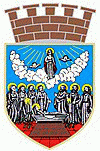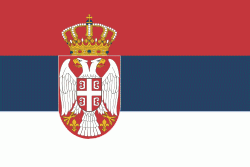Zrenjanin (Opština Zrenjanin)
 |
Zrenjanin is the largest city in the Serbian part of the Banat geographical region, and the third largest city in Vojvodina (after Novi Sad and Subotica). The city was designated European city of sport.
The city was named after Žarko Zrenjanin (1902–1942) in 1946 in honour and remembrance of his name. One of the leaders of the Vojvodina communist Partisans during World War II, he was imprisoned and released after being tortured by the Nazis for months, and later killed while trying to avoid recapture.
The former Serbian name of the city was Bečkerek (Бечкерек) or Veliki Bečkerek (Велики Бечкерек). In 1935 the city was renamed to Petrovgrad (Петровград) in honor of king Peter I of Serbia. It was called Petrovgrad from 1935 to 1946.
In Hungarian, the city is known as Nagybecskerek, in German as Großbetschkerek or Betschkerek, in Romanian as Becicherecul Mare or Zrenianin, in Slovak as Zreňanin, in Rusin as Зрењанин, in Croatian as Zrenjanin, and in Turkish as Beşkelek (meaning five melons) or Beçkerek.
It is assumed that Zrenjanin's original name, Bečkerek/Becskerek, comes from Hungarian word kerek ("forest, grove") and the surname of the 14th-century nobleman, Imre Becsei, who had large estates in the area. Therefore, the name would be translated into English as "Becsei's Forest".
The original name received an adjective meaning "great/big/major" in the languages of the Banat (Veliki or Велики, Danube Swabian: Groß, Nagy, Mare), to distinguish it from a village of the same name in the Romanian Banat, that is usually referred to as small Bečkerek (cf. Serbian: Mali Bečkerek or Мали Бечкерек, Danube Swabian: Kleinbetschkerek, Becicherecu Mic, Kisbecskerek).
Map - Zrenjanin (Opština Zrenjanin)
Map
Country - Serbia
 |
 |
| Flag of Serbia | |
Continuously inhabited since the Paleolithic Age, the territory of modern-day Serbia faced Slavic migrations in the 6th century, establishing several regional states in the early Middle Ages at times recognised as tributaries to the Byzantine, Frankish and Hungarian kingdoms. The Serbian Kingdom obtained recognition by the Holy See and Constantinople in 1217, reaching its territorial apex in 1346 as the Serbian Empire. By the mid-16th century, the Ottomans annexed the entirety of modern-day Serbia; their rule was at times interrupted by the Habsburg Empire, which began expanding towards Central Serbia from the end of the 17th century while maintaining a foothold in Vojvodina. In the early 19th century, the Serbian Revolution established the nation-state as the region's first constitutional monarchy, which subsequently expanded its territory. Following casualties in World War I, and the subsequent unification of the former Habsburg crownland of Vojvodina with Serbia, the country co-founded Yugoslavia with other South Slavic nations, which would exist in various political formations until the Yugoslav Wars of the 1990s. During the breakup of Yugoslavia, Serbia formed a union with Montenegro, which was peacefully dissolved in 2006, restoring Serbia's independence as a sovereign state for the first time since 1918. In 2008, representatives of the Assembly of Kosovo unilaterally declared independence, with mixed responses from the international community while Serbia continues to claim it as part of its own sovereign territory.
Currency / Language
| ISO | Currency | Symbol | Significant figures |
|---|---|---|---|
| RSD | Serbian dinar | дин or din. | 2 |
| ISO | Language |
|---|---|
| BS | Bosnian language |
| HU | Hungarian language |
| SR | Serbian language |
















